In 2015, photographer Kevin McElvaney flew to Izmir, Turkey, with fifteen single-use cameras, which he then distributed to refugees from various Middle Eastern countries. He asked these individuals to document their realities and to send the cameras back to him so he could develop their photos and curate them into a project that he titled “Refugee Cameras.” McElvaney had embarked on this program after asking himself how he, as a professional photographer, might capture the unfolding human catastrophe caused by mass waves of forced migration. He concluded that significant dimensions of this global event would remain essentially unknowable to him, so he gave the cameras to those who knew. In what follows, we travel to another historical context to inquire about what migrants and refugees “knew” and how they choose to communicate their knowledge in their photographic work.
In the 1920s, the photo camera underwent a multitude of literal and figurative metamorphoses. First and foremost, the decade brought about two camera models that became the most popular of the time and dominated the market for years to come: the Leica and the Rolleiflex, both lightweight and easy to handle. These models, and some of their cheaper imitations, brought about an entirely new approach to the photographic profession. Most importantly, these new models made the camera more mobile, enabling it to conquer the city street and capture—sometimes even secretly—those fleeting instances that are idiosyncratic of the human encounter.1 The camera’s new mobility opened up the business to self-made artists and reporters. Everyone with a camera could acquire guidance from handbooks like the popular 1926 Pressephotographie und Bildberichterstattung (Press Photography and Photojournalism).2 The new accessibility of photography endowed any bearer of a camera with a latent political voice: it made it possible to witness and report about social and political change. The new mobility the camera both gained and granted also offered chances to those whose own lives would be shaped by mobility, for example, émigrés and refugees forced to leave Germany due to racialized or political exclusion. As such photography became a form of documentation of newly gained knowledge and insights, and the camera turned into an object, carrier, and catalyst of knowledge itself.3
That the camera was understood as an asset can be seen from advertisements in the Jewish press. During the 1930s, these promoted photography skills to emigrants as a resource that could be put to use at any time in their new homes.4 Here we explore how such cameratic knowledge was applied to the situation of migratory travel. Specifically, we engage with the liminal spaces of stateless wanderings and the observations that came with them. We do not approach the camera as a flexible instrument so much as we ask how it helped migrants and stateless travelers make sense of the places they passed through in their search for a new home. How did the photographic knowledge, skills, and insights of these people change? And how did they help those on the move to put their newly acquired knowledge into a language by means of which they could share their experiences?5 To get at such issues, we explore the camera as a travel companion in a strange new world, one the bearer approached with the “disinterested” curiosity afforded by the device. More specifically, we analyze the camera’s output, the photographs, and we attend to the positionality of their creators as mobile agents.
Refugee Observer: Gabriele Gutkind in London
I am in your city one week. I send you the pictures of the things I see. I write for each picture what it is I like.6
Twenty-one years old in 1939, Gabriele Gutkind was one of approximately 70,000 Jewish refugees in the United Kingdom. Fleeing Nazi persecution in her hometown of Berlin, she arrived in London in the summer, joining her father, architect and urban planner Erwin A. Gutkind, who had migrated several years earlier. The lines quoted above come from a photographic storytelling piece that Gutkind published shortly after her arrival in Picture Post. Known not only for the distinguished quality of its content but also for its antifascist stance, this photojournalistic magazine was a particularly apt forum for the young photographer’s very first impressions of her new surroundings.7
Gabriele Gutkind sought to launch her career as a photographer at a time when Nazism’s legislated antisemitism was choking off any remaining professional opportunities still in Germany. She nonetheless managed to obtain a few commercial commissions.8 Moreover, in March 1938, the Jüdischer Kulturbund (Cultural Federation of German Jews) even put on a solo exhibition of her works that received positive reviews in the German-Jewish press.9 As she prepared to migrate to England, she remained set on pursuing photography professionally and so applied for special permission from Nazi authorities to take her recently purchased photography equipment with her. This was necessary because in 1938, when Gutkind was planning her departure, Jews were prohibited from emigrating with items purchased before 1933 without a special permit. Her request was granted, most likely because she explained that the equipment was a professional necessity.10
Gutkind was but one of many photographers whose lives were uprooted by National Socialism. My colleague, Rebekka Grossmann, has explored this fascinating history with a particular focus on Mandate Palestine.11 In the field of migration studies, photography is often addressed in two key manners: first, as source material that provides visual documentation of mobile groups; second, as a way for host societies to represent mobile groups in their media. In each case, migrants are the objects of the photographer’s gaze. Works by photographers like those at the heart of Rebekka Grossmann’s research, however, show that scholars have much to gain by considering migrants as subjects behind the camera as they confronted their changing surroundings.
Gabriele Gutkind’s example certainly suggests as much, particularly in light of the photos that she published in Picture Post. The double spread that the magazine dedicated to her work presents an array of visual impressions that Gutkind assembled during her very first days in London. At first glance, Gutkind’s photographs offer little novelty to native readers of the magazine. Depicting day-to-day scenes from the capital that many would describe as mundane, the photos nevertheless reflect a unique moment of encounter between the foreign photographer and the city that she had entered as a refugee. In turning her camera lens toward the ordinary objects of London’s urban spaces, Gutkind communicated these scenes back to the magazine’s readers from her own perspective. Yet the knowledge that she conveyed in her photos was less concerned with her life experience as an Other and more with her ability to see others. Rather than placing her foreignness at the center, Gutkind offered her photojournalistic observations to suggest to British readers how they might be perceived as foreign to people like herself.
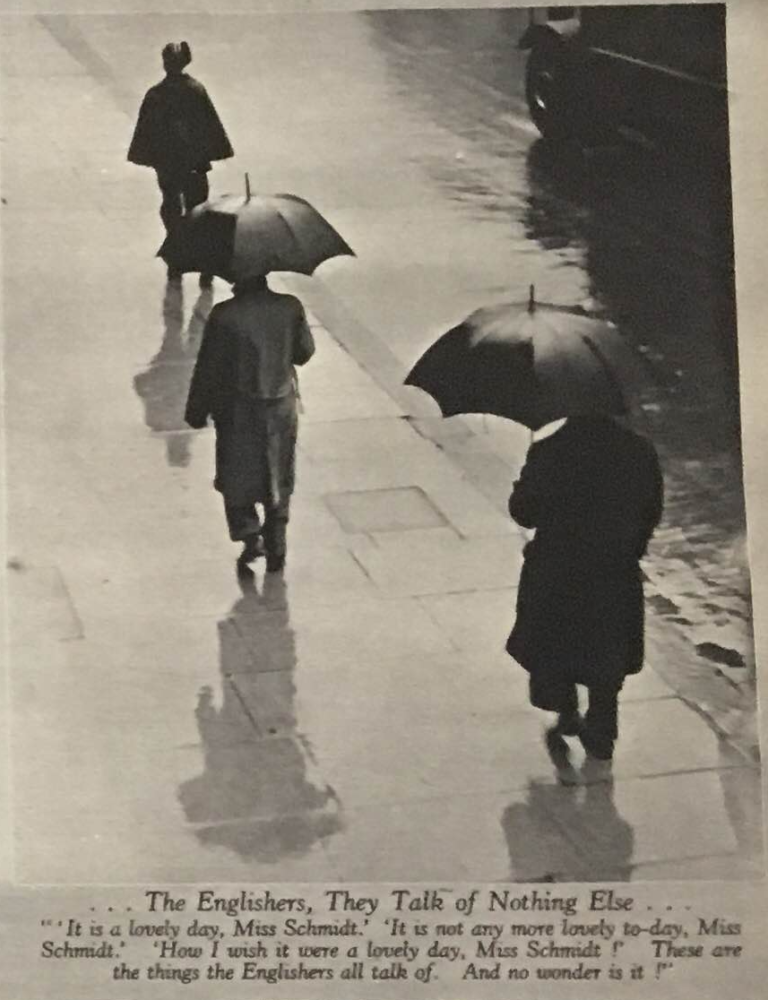
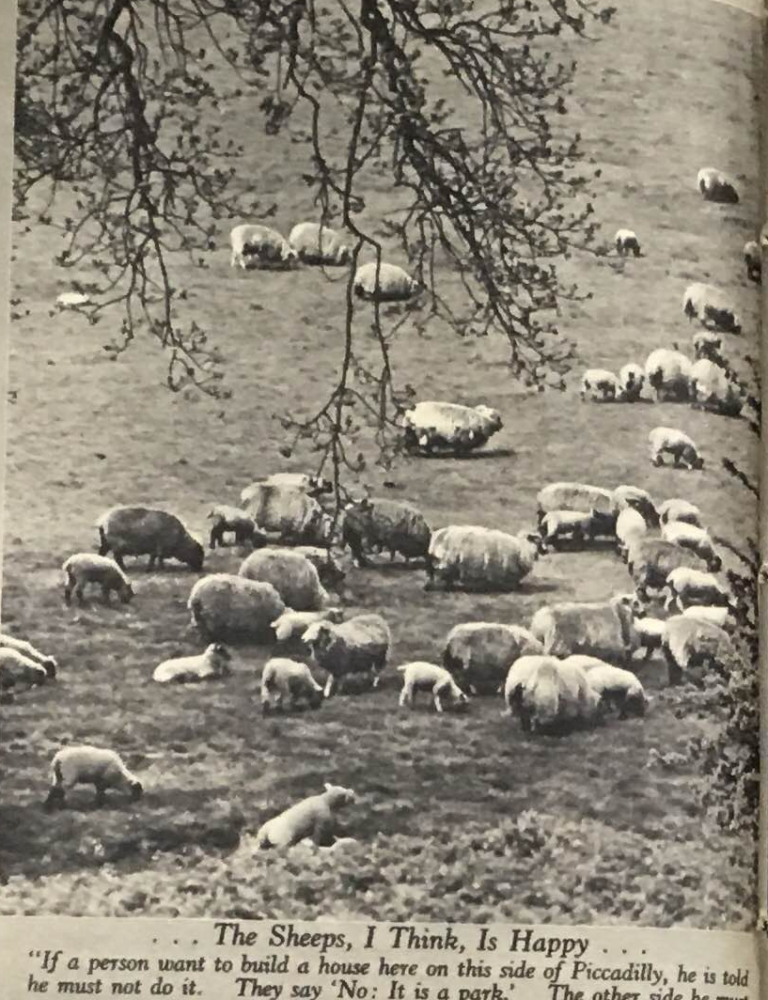
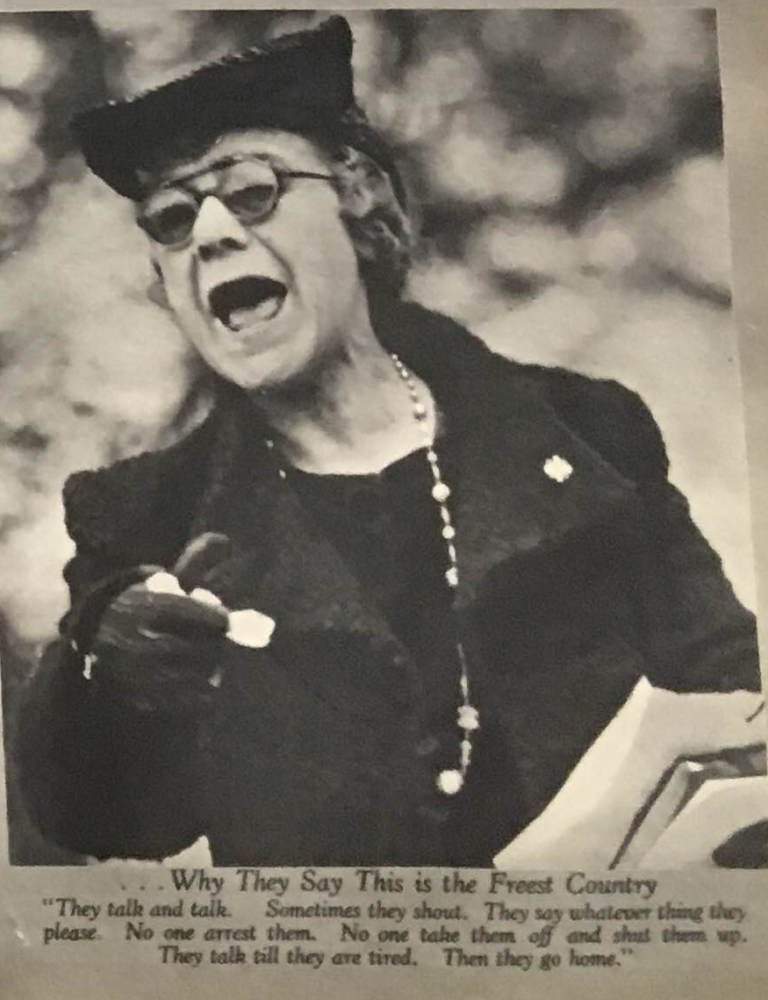
Each of the images was accompanied by a brief description that expressed the young refugee’s appreciation toward the country that had granted her asylum and also poked a little fun at it. Alongside Gutkind’s own humoristic takes, the magazine editors’ decision not to correct her grammatical errors was perhaps meant to boost the comedic effect and to accentuate her positionality as an outsider. “The Englishers, They Talk of Nothing Else” is the title of one of the photos (Figure 1), showing a rainy street scene with men in trench coats huddled under umbrellas. The caption of the photo reads: “‘It is a lovely day, Miss Schmidt.’ ‘It is not any more lovely to-day, Miss Schmidt.’ ‘How I wish it were a lovely day, Miss Schmidt!’ These are the things the Englishers all talk of. And no wonder is it!” The cheerful chitchat that Gutkind imagined between Mrs. Schmidt and her counterpart stands in contrast to the dreary image of lone pedestrians in a rainy street. Combined, text and photo provide a more comprehensive notion of this young refugee’s impression of London.
In another photo, titled “The Sheeps, I think, Is Happy” (Figure 2), Gutkind remarked on how costly it is for people to own homes on one side of Piccadilly road, while sheep get to roam and live for free in Green Park, an area designated as a green space where construction is forbidden, just on the other side of Piccadilly. What otherwise might appear as a quaint nature scene is communicated here through Gutkind’s process of gradually acquiring more familiarity and knowledge of her surroundings, situating her commentary both topographically and socially within the cityscape, its rules, and its human and other inhabitants. If the image offers little more than a bucolic scene of herding sheep, Gutkind’s caption served to map the scene on the urban logic of London, the city that Gutkind was studying through her camera lens.
In other photographic observations, Gutkind’s perspective on her subjects is clearly influenced by her own recent experience in Nazi Germany. “Why They Say This is the Freest Country” (Figure 3) depicts a woman that appears to be giving a speech outdoors, perhaps at London’s famous Hyde Park Speakers’ Corner, where every person is allowed to mount a soapbox and speak publicly on whatever topic they see fit, whether an audience gathers to listen or not. Gutkind’s description reads: “They talk and talk. Sometimes they shout. They say whatever thing they please. No one arrest them. No one take them off and shut them up. They talk till they are tired. Then they go home.” The sense of freedom that Gutkind identifies in British citizens’ ability to speak publicly is mirrored by her own freedom to roam the streets of London, take photos as she more or less pleased, and even to have her work printed and distributed to the general public. In Germany, not only had her ability to work and publish been increasingly restricted. Under the Nazi reign of terror, even amateur photography in public spaces could pose a risk.12
In her Picture Post photo series, Gutkind’s foreignness is not simply evident, it is emphasized. The magazine’s decision not to impose edits on her language only served to strengthen her creative choices to explicitly address the encounter between herself, the refugee, and the society that she had entered. Embracing her position as an Other, Gutkind chose not to put herself and her experiences at the center but rather to deliver to the readers a light-hearted portrayal of them as seen by an outsider. Her documentation and evaluation are both appreciative and sober. Without exalting England, she acknowledged what it meant for her to be there, to be safe. Playfully teasing her audience, Gutkind maintained the freedom to narrate her journey from the perspective of an observer—a perspective that displaced people are so often robbed of. Gutkind approaches the magazine’s readers with a daring proposition: Despite being a newcomer to London, she has insight into the city and the people who live in it. And if they choose to listen, they might just learn something about themselves.
Exploring (in) Exile: Travel and Photography
Some photographers, particularly those who already had a track record of journal publications or photojournalism, deliberately turned to travel in times of crisis. Most of the photojournalists who had shaped the profession and taught readers to “see the world photographically” belonged to circles of the liberal press, and many of them were Jews.13 In the later years of the Weimar Republic, they were increasingly targeted and, after March 1933, forcefully excluded and persecuted.14 Extended travels offered a means to stay away from Germany while offering opportunities for freelance photojournalism and ways to supply employers at home with photographs from their journeys, at least until most of the liberal papers were dismantled. The resulting images show that these travels shaped the photojournalists’ gaze. Abroad, they sought to apply similar techniques to those acquired back home to engage with their subjects, for example, by reducing the distance to photographed subjects or by depicting them from low or high angles in order to force audiences to actively perceive them.15 Not always, however, could they transfer their photographic skills to new environs. Instead, their photographs show that sometimes they were forced to adjust their modes and approaches, for example, when their interlocutors were unfamiliar with the camera and thus shy or skeptical, or when, by contrast, their subjects sought to present themselves with a certain pose. The photographers’ travels thus forced them to adapt their gaze.
Photography and travel have always made a compelling combination. However, the travel photography that dominated Weimar visual culture was not exactly the terrain German-Jewish photographers had moved in. Instead, 1920s travel photography centered on bringing the “exotic” home; the more foreign the photographic views, the more intriguing they proved for the armchair traveler. For the same reason, such photography often directed the gaze to the unknown and avoided any familiar traits of the countries and landscapes presented. This kind of gaze was enhanced by techniques to embellish a scene’s aura with shadows or clouds, added, at times, with a brushstroke in the dark room.16 Long angles that captured the entirety of the scene were preferred over close-ups. Weimar Germany’s photographic avantgardes, in contrast, including many of the German Jews who had entered photojournalism as freelancers or mingled with photographers and artists of the Bauhaus, were all about making the strange familiar, driven by an entirely different set of techniques, including a fascination for close-ups and strange angles.17 Finally, Weimar’s photographers guild focused on the political and the topical, whereas “traditional” travel photography sought to escape to the timeless moment, away from any political upheaval.18 The latter desire often manifested in the subjectified traveler’s impressions, which contrasted with the desire of the Neues Sehen movement (also called New Vision) to objectify views and viewpoints.
In examining the intersections of the social documentary photography minted by Weimar Germany’s avantgardes and the genre of travel photography as part of a “photography of migration,” I draw, in particular, on insights I gained from working with my colleague Sheer Ganor, who examines the situationality and ephemerality of diaspora as a space for individual agency.19 Further inspiration stems from scholarship that suggests we could profit from combining migration studies with the scholarly examination of travel as a social practice.20 If we read the experience of migration as travel, even if the travel is entirely involuntary, we can understand our protagonists’ mobility as what David Myers calls “a practice of observation—both by and of Jews.”21 Taking his suggestion of the traveler’s observations literally means to combine the history of Jewish travel and migration with the analytical lens of photography. The camera documented encounters that happened along the journeys of migrants and exiles. To analyze them not only as haphazard events but also as processes of identification and learning, cultural translation and transfer, and active engagement with the scene and its implications for the observers’ understanding of local political and social dynamics means to read the photographer’s cameratic travels through the lens of knowledge shaped by the movement of migration. The following examples offer insights into knowledge of this kind, knowledge that helped photographers to make sense of their own situation as refugees, of the new social and political contexts, and of the local traditions of the places they moved through. The examples also reveal some of the meanings and effects that the medium of photography had as a political language.
One example is the work of Hans Casparius. Born in 1900 in Berlin, he had come to photography via film. During the Weimar years, he worked as a still photographer for the renowned director G. W. Pabst, documenting the evolution of Pabst’s films.22 From 1930 onward, Casparius accompanied the correspondent of the Berliner Tageblatt, Arnold Höllriegel, to destinations all over the world and worked as Höllriegel’s photographer.23 Together they toured West Africa, Alaska, Canada, and Libya.24 While the travels began as adventures, they became escape routes. Upon their return from Libya, Casparius did not go to Berlin but joined Höllriegel in Vienna. One of his last trips before settling in London brought him to Palestine, this time with a colleague of Höllriegel’s, Arthur Rundt. The photographs he took on this journey don’t resemble those of an immigrant or tourist in Palestine. Instead, his style follows the one he developed during his previous journeys as a curious explorer.
Consider his photograph of two young children and a camel in the ruins of Ashkelon (Figure 4). Here he left the beaten path of 1930s sightseeing in Palestine. Although he also captured Tel Aviv beaches and Jerusalem scenes, this image offers a different photographic event. The camel is no picturesque extra but can almost be recognized as an active participant in the photographic encounter. The Roman ruins, normally at the center of visitors’ attention, are rendered incidental to a scene that instead has their present-day inhabitants or neighbors at its center, children, who have repurposed what seem like ancient columns and statues to serve as their playground. Both the boy and the camel display interest in the photographer, while the younger child remains aloof, less intrigued or too shy to engage with the camera. The photograph exemplifies the shifted gaze of the traveler Casparius away from the country’s monuments and toward its people. Casparius’ traveler’s camera has ceased to merely record journeys to be reenacted by readers at home. Instead it has turned into a medium of personal encounter shaped by the curiosity of a long-time traveler and practiced photojournalist.
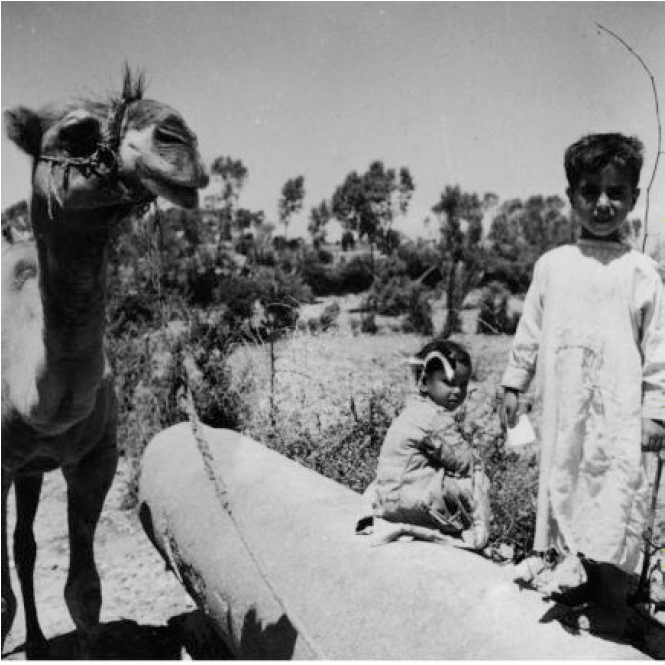
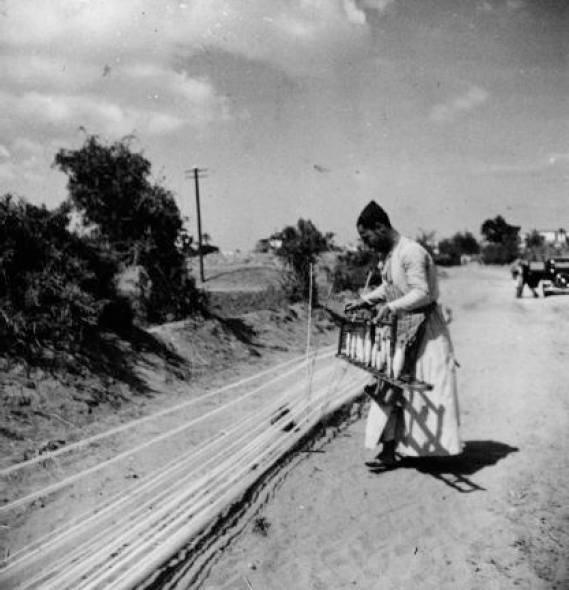
Another example is a series of images in which Casparius documented local handiworks. In one of them (Figure 5), the photographer emphasizes the elegance of local weaving techniques by offering an angle that enables onlookers to see the length of the strings spanned across a path. Casparius was interested in the traditions of knowledge to which the sophisticated processes and products of local artisans attest. As such, his work stands in stark contrast to earlier travel photography, which often sought to confirm the higher degree of development of one’s own Western gaze. His images also eschew a kind of Jewish national view eager to provide before-and-after views of Palestine’s barren landscapes, engineered and brought to life by Zionist settlement activity.
Although many of Hans Casparius’ photographs would be compiled in a pictorial record of Palestine entitled Palästina Bilder-Buch (1934), neither one of the photographs shown here was included. Like many, they remained in Casparius’ personal collection, too “unusual” for a book intended to convince German Jews intent on emigrating to choose Palestine as their destination. To Casparius they were natural ways to engage with and capture Palestine’s population on its own terms, and to observe its habits and traditions. His camera was not only that of a visitor. Instead he also seemed to be extending traditional tourists’ or Zionists’ views of a country whose traditions were more complex than previously published photographs had suggested.
Another instructive example is the German Jewish photographer Tim Gidal, who reached India and Ceylon in 1940 via a variety of detours and stations. Similarly to Casparius, Gidal tried to combine permanent and contingent aspects of the realities he saw. Like Casparius, Gidal was interested in local crafts, as in a photograph of mainly children and women collecting the tea harvest in their self-made baskets (Figure 6).
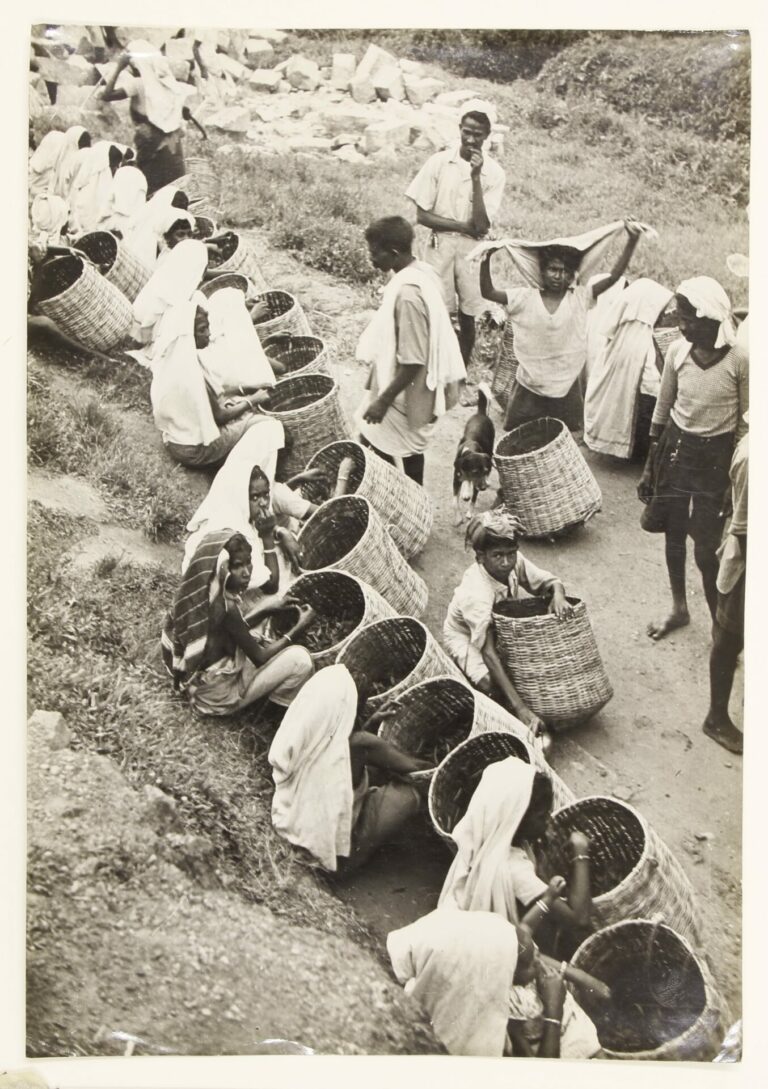
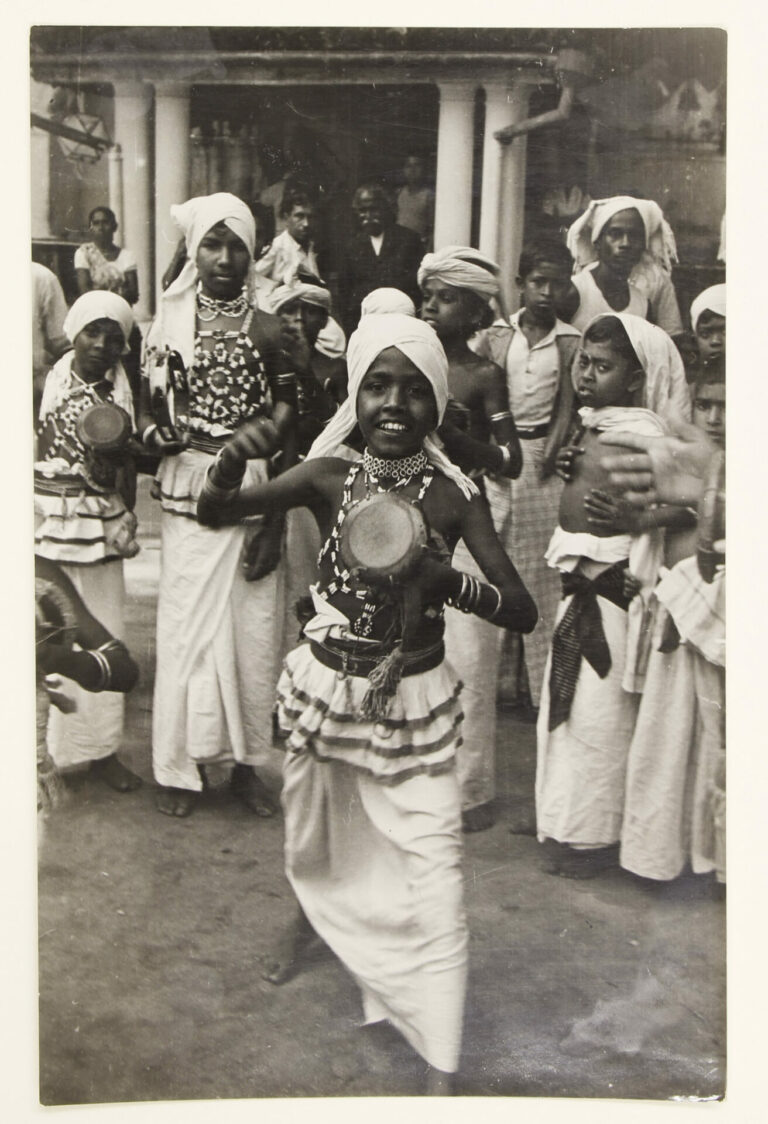
The white headscarves contrast in shape and tone with the dark circles drawn by the openings of the baskets. The mélange of artisanal tradition and visual dynamics mirrors Gidal’s understanding of the local and national upheavals, including the unequal synchronies of the region, which he here turns into visuals. Although in his memoirs he expressed special pride about portraying Mahatma Gandhi, his journeys on more rural parts form integral elements to his discovery of the subcontinent. A photograph he shot of a parade in Ceylon (Figure 7) offers further evidence of the camera having served as a translation device, initiating and facilitating encounters driven by curiosity and playfulness, often with a special focus on children, who tended to display a particular approachability in contact with the travelers and their cameras. It is almost as if there is a special affinity between these children and the foreigners.
These photographs are not necessarily complex in their style or technique. But they testify to how stateless photographers encountered their surroundings, driven by the curiosity of the traveler and the immediacy of the documentary photographer. Their photographs attest to their understanding of the possibility of putting their aimless travels to political use by extending or overcoming perceptions and opinions by means of the camera. Circulating such images could gain them some measure of agency at a time when their voices had almost entirely been muted. The local insights these photographs convey entail more than a Western tradition of enlightening viewers about foreign mores from the safe distance of the observer. They offer intimate portraits that render the formerly foreign familiar. This does not mean that this encounter was free of the power granted to the holder of the camera, but the agency of the photographic meeting was partly shared. Their travels turned the photographers into insiders on local political developments and struggles. Judging from the circulation of the images Gidal produced, for example, this knowledge turned out to be attractive to news outlets worldwide. The cameras of these photographers served not only as mediating devices on their stateless journeys, the devices also sharpened their holders’ views for social and political problems. These special insights left traces of idiosyncratic migrant knowledge in their pictures.25
Even amateur photographers made sure to capture their encounters with the new and unknown. A photograph of a Chinese boy on his bike cart in a Shanghai street (Figure 8) is exemplary for the large number of images taken by exiled travelers on their journeys. It resembles the typical tourist gaze taken of the foreign and exotic. The gaze of the photographer and the boy meet, each one inspects the other, while the boy knows that his appearance is captured for others to see. Yet the position of the camera is one of conflicted power and agency. The security of the darkroom and the possibility of publishing or neatly arranging the photographs in an album becomes compromised for the traveling photographer, who does not know where he or his films and photographs will end up. Nonetheless, photographers such as this one had the chance to use their cameras as a medium for translating their experiences into visual traces to be shared, shown, and kept as memories of wide-ranging experiences.
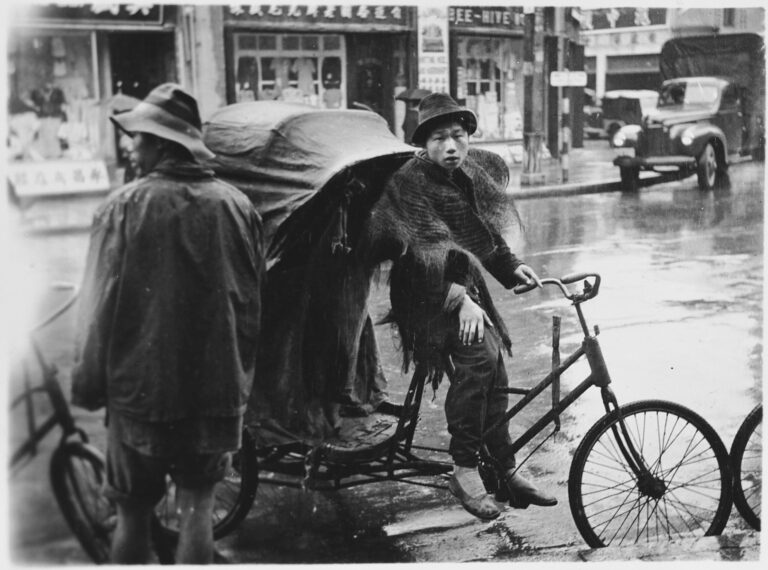
Transmitting Cameratic Knowledge
Photographs like the ones presented here, taken in London, Palestine, India, and Shanghai, help to ask new questions about the experiences of migrants, the state of being in exile, and the impact of diaspora on the modern Jewish experience. Approaching them through the combined lenses of visual history and the history of migrant knowledge reveals that photography was not only an asset in times of crisis. It was not merely a mobile profession. It also served as a way to perceive the world around the migrants and to capture images, ideas, and insights that could be shared globally. The photographers employed and gained cultural knowledge, and their photographs both bear witness to this process and form part of it.


Rebekka Grossmann is currently a postdoctoral fellow at the Franz Rosenzweig Minerva Research Center for German-Jewish Literature and Cultural History at the Hebrew University of Jerusalem. Her research focuses on the intersections of Jewish political history, migration and mobility, and global visual culture. Her Twitter handle is @rmgrossmann.
- Timm Starl, Knipser: Die Bildgeschichte der privaten Fotografie in Deutschland und Österreich on 1880 bis 1980, (Munich: Koehler & Amelang, 1995), 94–98. ↩︎
- Ludwig Boedecker, Pressephotographie und Bildberichterstattung (Bunzlau: Verlag “Der Photograph” L. Fernbach, 1926). ↩︎
- See , e.g., Annette Vowinckel, “German (Jewish) Photojournalists in Exile: A Story of Networks and Success,” German History 31, no. 4 (2013): 473–96. For additional studies offering insights into the intersections of Jewish migratory mobility and photography, see Michael Berkowitz, “Photography as a Jewish Space,” in Space and Spatiality in Modern Jewish History, ed. Simone Lässig and Miriam Rürup (New York: Berghahn Books, 2017), 246–62; and Maiken Umbach, Photography, Migration, and Identity: A German-Jewish-American Story (Abingdon: Palgrave MacMillan, 2018). ↩︎
- Jüdisches Nachrichtenblatt, July 23, 1938, 8. ↩︎
- Simone Lässig and Swen Steinberg, “Knowledge on the Move: New Approaches toward a History of Migrant Knowledge,” in “Knowledge and Migration,” ed. Lässig and Steinberg, special issue, Geschichte und Gesellschaft 43, no. 3 (2017): 316. ↩︎
- “A German Girl Came to London,” Picture Post, August 26, 1939, 58. ↩︎
- The founding editor of the Picture Post, Stefan Lorant, was himself a refugee. He had escaped Nazi persecution after being imprisoned in 1933 and had used his connections and networks to aid photographers seeking a path out of Central Europe. See Vowinckel, Photojournalists, 478–80. ↩︎
- The private collection of her grandmother, Elise Gutkind, contains a copy of a jewelry advertisement that seems to have resulted from one of these jobs: The Gutkind family chronicle, Leo Baeck Institute New York, LBI Manuscript Collection, AR 5815, 230, available online at the Internet Archive. ↩︎
- Excerpts of the press coverage are available in Gutkind’s private collection at the Jewish Museum Berlin, 2002/61/37-40. ↩︎
- More clippings from Gutkind, Jewish Museum Berlin, 2002/61/10-11. ↩︎
- See, e.g., Rebekka Grossmann, “Image Transfer and Visual Friction: Staging Palestine in the National Socialist Spectacle,” Leo Baeck Institute Yearbook 64, no. 1 (2019): 19–45; and Rebekka Grossmann, “Negotiating Presences: Palestine and the Weimar German Gaze,” Jewish Social Studies 23, no. 2 (2018): 137–72. ↩︎
- Christoph Kreutzmüller, “Bilder der Bedrohung: Von Juden aufgenommene Fotos der Verfolgung,” Medaon 12, no. 23 (2018): 1–6. For more on Jewish amateur photography in Nazi Germany, see Ofer Ashkenazi, “Exile at Home: Jewish Amateur Photography under National Socialism, 1933–1939,” Leo Baeck Institute Year Book 64, no. 1 (2019): 115–40. ↩︎
- Daniel Magilow, The Photography of Crisis: The Photo Essays of Weimar Germany (University Park, PA: The Pennsylvania State University Press, 2012), 34–62, quote 37. On Jews in Weimar German photographic circles, see Berkowitz, “Photography as a Jewish Space,” 249. ↩︎
- Rolf Sachsse, “‘Dieses Atelier ist sofort zu vermieten’: Von der ‘Entjudung’ eines Berufsstands,” in “Arisierung” im Nationalsozialismus: Volksgemeinschaft, Raub und Gedächtnis, ed. Irmtrud Wojak and Peter Hayes (Frankfurt am Main: Campus, 2000), 271–72; Diethart Kerbs, “Die Epoche der Bildagenturen: Zur Geschichte der Pressefotografie in Berlin von 1900 bis 1933,” in Die Gleichschaltung der Bilder: Pressefotografie 1930–1936, ed. Diethart Kerbs, Walter Uka, and Brigitte Walz-Richter (Berlin: Frölich & Kaufmann, 1983), 62, 66, and 68. ↩︎
- Britta Schilling, “Crossing Boundaries: German Women in Africa, 1919–1933,” German Colonialism and National Identity ed. Michael Perraudin and Jürgen Zimmerer (New York: Routledge, 2010), 145. ↩︎
- On photographic pictorialism, see, e.g., Helmut Gernsheim, A Concise History of Photography (London: Thames and Hudson, 1971). 161–66. ↩︎
- Herbert Molderings, “Überlegungen zur Fotografie der neuen Sachlichkeit und des Bauhauses,” Kritische Berichte, 1977, 67–88. ↩︎
- Roland Jaeger “Die Länder der Erde im Bild: Die Reihe Orbis Terrarum im Verlag Ernst Wasmuth, Berlin, und im Atlantis-Verlag, Berlin/Zürich,” Autopsie: deutschsprachige Fotobücher 1918 bis 1945, ed. Manfred Heiting and Roland Jaeger (Göttingen: Steidl, 2012), i:101–102. ↩︎
- See, e.g., Sheer Ganor, “To Farm a Future: The Displaced Youth of Gross-Breesen,” in “Histories of Migrant Knowledge: Transatlantic and Global Perspectives,” ed. Andrea Westermann and Onur Erdur, Bulletin of the German Historical Institute, Supplement 15: (2020): 19–40; and Sheer Ganor, “Forbidden Words, Banished Voices: Jewish Refugees at the Service of BBC Propaganda to Wartime Germany,” Journal of Contemporary History 55, no. 1 (2020): 97–119. ↩︎
- See, e.g., Johannes F. Evelein, “Traveling Exiles, Exilic, Travel—Conceptual Encounters,” in Exiles Traveling: Exploring Displacement, Crossing Boundaries in German Exile Arts and Writings 1933–1945, ed. Johannes F. Evelein (Amsterdam: Rodopi, 2009), 11–32; Joachim Schlör, “Solange Wir auf dem Schiff waren, hatten wir ein Zuhause: Reisen als kulturelle Praxis im Migrationsprozess jüdischer Auswanderer,” Voyage: Jahrbuch für Reise und Tourismusforschung 10 (2014): 226–46. ↩︎
- David N. Myers, “Editor’s Introduction: The Condition of Travel,” Jewish Quarterly Review 99, no. 4 (2009): 437. ↩︎
- Among these films were the adaption of Brecht’s Threepenny Opera as well as “Die Weisse Hölle vom Pitz Palü.” See Pieter O’Leary, “Hans Casparius,” in Photo: Casparius, ed. Gero Gandert, Hans-Michael Bock, and Jürgen Berger (Berlin: Stiftung Deutsche Kinemathek, 1978), 12. ↩︎
- Ofer Ashkenazi, “Strategies of Exile Photography: Helmar Lerski and Hans Casparius in Palestine,” in Back to the Future: Tradition and Innovation in German Studies, ed. Marc Silberman (Oxford: Peter Lang, 2018), 96. ↩︎
- Hans Feld, “Portrait of an Eccentric: Hans Casparius: Photographer and Film-Maker,” Filmexil: Stiftung Deutsche Kinemathek 3 (1993): 50. ↩︎
- Lässig and Steinberg, “Knowledge on the Move,” 337–38. ↩︎
